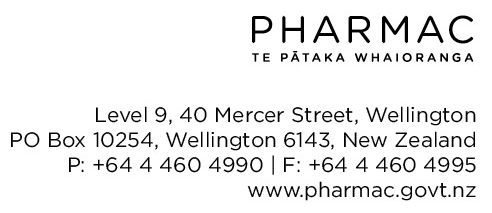
24 January 2025
Laydan Mortensen
Via email:
fyirequest29777[email address]
Tēnā koe Laydan
Request for information: Trikafta health claims
Thank you for your request dated 17 January 2024 under the Official Information Act 1982
(the Act) for information relating to Trikafta. You requested:
On 15 August 2022, Pharmac made a press release (https://pharmac.govt.nz/news
andresources/news/20220815mediareleasepharmacsharesupdateonits
assessmentoftrikafta) on the funding application for Trikafta
(elexacaftor/texacaftor/ivacaftor) stating: "We also estimate that Trikafta could give
people with cystic fibrosis who are aged 6 and over a longer and improved quality of
life – specifical y benefits equivalent to 27 more years at ful health when compared to
current funded treatments." The "27 more years at ful health" figure has been widely
publicised by advocacy groups and the media, but I can't seem to find a source or
any form of calculation on how that figure was obtained. The closest I got was from
the publiclyavailable technology assessment report, which show an incremental
QALY gain of 9.8 years, just a third of the stated 27 years.
Can you please release information of how the "27 more years at ful health" figure
was calcuated?
The incremental quality adjusted life year (QALY) gain of 9.8 years mentioned in your
request represents the
discounted QALY gain per individual expected if Trikafta were used
instead of the treatments funded at that time. In contrast, the ‘27 more years at ful health’
reflects the
undiscounted QALY gain per person. Pharmac does not routinely report
undiscounted QALYs in the technology assessment reports (TARs), like the one you refer to
which was published online.
Given that cystic fibrosis is a chronic, progressive disease and Trikafta is likely to provide
health benefits over a long period (a person’s lifetime), applying Pharmac’s discount rate of
3.5% to both costs and outcomes in the economic model results in a significant difference
between discounted and undiscounted QALY gains.
Pharmac aims to secure the best health outcomes reasonably achievable within the provided
funding. To identify proposals that would deliver these outcomes if funded, Pharmac uses
economic analysis, which is a valid, replicable, and scientific tool. The Prescription for
Pharmacoeconomic Analysis (PFPA) outlines Pharmac’s methodology for conducting
economic analyses to assess the value for money of pharmaceuticals in New Zealand.
202425103

Most economic analyses are written up as Technology Assessment Reports (TARs), like the
publicly available report you referenced. The economic assessment of Trikafta was
conducted using a costutility analysis (CUA). A CUA compares the costs and outcomes
(health benefits) of different treatment options. The qualityadjusted lifeyear (QALY) metric,
which combines changes in both the quantity and quality of life (mortality and morbidity) into
a single measure, is used to evaluate health benefits in a CUA.
In accordance with the PFPA, costs and benefits in a CUA are discounted at a rate of 3.5%.
Discounting is used to compare treatments with costs and benefits occurring at different
times by reflecting their present value. This approach assumes that immediate resources are
more valuable than those in the distant future, a concept known as time preference. As a
result of discounting, costs and health benefits occurring earlier in the economic model are
given more weight than those occurring later. Consequently, when discounting is applied to
interventions with costs and benefits accrued over many years, future costs and health
benefits are heavily discounted. This means discounted health benefits (QALYs) are quite
different to undiscounted QALYs, and likewise, discounted future costs of treatment and
other health sector care are very different to undiscounted costs.
We trust that this information answers your queries. Please note, you have the right to make
a complaint to the Ombudsman about our response to your OIA, under section 28(3) of the
OIA. Details of
how to make a complaint are on the Ombudsman’s website.
To make information more freely available, we publish selected OIA responses (excluding
personal details) on our website. Please get in touch with us if you have any questions about
this.
Nāku noa, nā
Oliver Whitehead
Team Leader, Government Services
2

